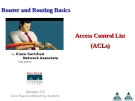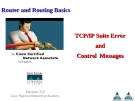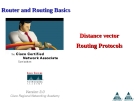Tài liệu Thư viện số
- Công nghệ thông tin (2019 )
- Điện tử viễn thông (1133 )
- Quản trị kinh doanh (1305 )
- Kế toán (1003 )
- Môi trường (968 )
- Du lịch (861 )
- Kiến trúc (424 )
- Xây dựng (1082 )
- Ngoại ngữ (302 )
- Y dược (1391 )
- Khoa học tự nhiên (874 )
- Khoa học xã hội (514 )
- Lý luận chính trị (573 )
- Sau đại học (243 )
- Tài liệu tham khảo khác (252 )
Danh mục TaiLieu.VN
- Mẫu Slide Powerpoint
- Luận Văn - Báo Cáo (344720)
- Kinh Doanh Marketing (65512)
- Kinh Tế - Quản Lý (48934)
- Tài Chính - Ngân Hàng (55898)
- Công Nghệ Thông Tin (142209)
- Tiếng Anh - Ngoại Ngữ (47066)
- Kỹ Thuật - Công Nghệ (134345)
- Khoa Học Tự Nhiên (107174)
- Khoa Học Xã Hội (82451)
- Văn Hoá - Nghệ Thuật (54408)
- Y Tế - Sức Khoẻ (173915)
- Nông - Lâm - Ngư (62504)
- Kỹ Năng Mềm (29016)
- Biểu Mẫu - Văn Bản (27610)
- Giải Trí - Thư Giãn (51994)
- Văn Bản Luật (198854)
- Tài Liệu Phổ Thông (402015)
- Trắc Nghiệm Online (213578)
- Trắc Nghiệm MBTI
- Trắc Nghiệm Holland
Router and Routing Basics - Routing and Routing protocols
Routing is the process that a router uses to forward packets toward the destination network. A router makes decisions based upon the destination IP address of a packet. All devices along the way use the destination IP address to point the packet in the correct direction so that the packet eventually arrives at its destination. In order to make the correct decisions, routers must learn the direction to remote networks. When routers use dynamic routing, this information is learned from other routers. When static routing is used, a network administrator configures information about remote networks manually. Because static routes must be configured manually, any network topology changes require the network administrator to add and delete static routes to account for the changes. In a large network this manual maintenance of routing tables could require a tremendous amount of administrative time. On small networks with few possible changes, static routes require very little maintenance. Because of the extra administrative requirements, static routing does not have the scalability of dynamic routing. Even in large networks, static routes that are intended to accomplish a specific purpose are often configured in conjunction with a dynamic routing protocol.
Từ khóa: Routing protocols, Routing Basics, Networking basics, mạng cơ bản, kỹ thuật mạng, công nghệ mạng, Cisco Networking
27 p trinh 18/12/2012 203 2





